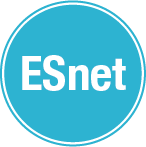
Network address translation (NAT) is a method of mapping an IP address space into another by modifying network address information in the IP header of packets while they are in transit across a traffic routing device. The technique was originally used to bypass the need to assign a new address to every host when a network was moved, or when the upstream Internet service provider was replaced, but could not route the network's address space. It has become a popular and essential tool in conserving global address space in the face of IPv4 address exhaustion. One Internet-routable IP address of a NAT gateway can be used for an entire private network.
In computer security, a DMZ or demilitarized zone is a physical or logical subnetwork that contains and exposes an organization's external-facing services to an untrusted, usually larger, network such as the Internet. The purpose of a DMZ is to add an additional layer of security to an organization's local area network (LAN): an external network node can access only what is exposed in the DMZ, while the rest of the organization's network is protected behind a firewall. The DMZ functions as a small, isolated network positioned between the Internet and the private network.

In computing, a stateful firewall is a network-based firewall that individually tracks sessions of network connections traversing it. Stateful packet inspection, also referred to as dynamic packet filtering, is a security feature often used in non-commercial and business networks.
Deep packet inspection (DPI) is a type of data processing that inspects in detail the data being sent over a computer network, and may take actions such as alerting, blocking, re-routing, or logging it accordingly. Deep packet inspection is often used for baselining application behavior, analyzing network usage, troubleshooting network performance, ensuring that data is in the correct format, checking for malicious code, eavesdropping, and internet censorship, among other purposes. There are multiple headers for IP packets; network equipment only needs to use the first of these for normal operation, but use of the second header is normally considered to be shallow packet inspection despite this definition.
A bastion host is a special-purpose computer on a network specifically designed and configured to withstand attacks, so named by analogy to the bastion, a military fortification. The computer generally hosts a single application or process, for example, a proxy server or load balancer, and all other services are removed or limited to reduce the threat to the computer. It is hardened in this manner primarily due to its location and purpose, which is either on the outside of a firewall or inside of a demilitarized zone (DMZ) and usually involves access from untrusted networks or computers. These computers are also equipped with special networking interfaces to withstand high-bandwidth attacks through the internet.
A middlebox is a computer networking device that transforms, inspects, filters, and manipulates traffic for purposes other than packet forwarding. Examples of middleboxes include firewalls, network address translators (NATs), load balancers, and deep packet inspection (DPI) devices.

The Energy Sciences Network (ESnet) is a high-speed computer network serving United States Department of Energy (DOE) scientists and their collaborators worldwide. It is managed by staff at the Lawrence Berkeley National Laboratory.
An application-level gateway is a security component that augments a firewall or NAT employed in a computer network. It allows customized NAT traversal filters to be plugged into the gateway to support address and port translation for certain application layer "control/data" protocols such as FTP, BitTorrent, SIP, RTSP, file transfer in IM applications. In order for these protocols to work through NAT or a firewall, either the application has to know about an address/port number combination that allows incoming packets, or the NAT has to monitor the control traffic and open up port mappings dynamically as required. Legitimate application data can thus be passed through the security checks of the firewall or NAT that would have otherwise restricted the traffic for not meeting its limited filter criteria.
An application delivery network (ADN) is a suite of technologies that, when deployed together, provide availability, security, visibility, and acceleration for Internet applications such as websites. ADN components provide supporting functionality that enables website content to be delivered to visitors and other users of that website, in a fast, secure, and reliable way.
An application delivery controller (ADC) is a computer network device in a datacenter, often part of an application delivery network (ADN), that helps perform common tasks, such as those done by web accelerators to remove load from the web servers themselves. Many also provide load balancing. ADCs are often placed in the DMZ, between the outer firewall or router and a web farm.
In computing, network virtualization is the process of combining hardware and software network resources and network functionality into a single, software-based administrative entity, a virtual network. Network virtualization involves platform virtualization, often combined with resource virtualization.

Junos OS is a FreeBSD-based network operating system used in Juniper Networks routing, switching and security devices.

In computing, a firewall is a network security system that monitors and controls incoming and outgoing network traffic based on predetermined security rules. A firewall typically establishes a barrier between a trusted network and an untrusted network, such as the Internet.
In information security, a guard is a device or system for allowing computers on otherwise separate networks to communicate, subject to configured constraints. In many respects a guard is like a firewall and guards may have similar functionality to a gateway.
Google Compute Engine (GCE) is the Infrastructure as a Service (IaaS) component of Google Cloud Platform which is built on the global infrastructure that runs Google's search engine, Gmail, YouTube and other services. Google Compute Engine enables users to launch virtual machines (VMs) on demand. VMs can be launched from the standard images or custom images created by users. GCE users must authenticate based on OAuth 2.0 before launching the VMs. Google Compute Engine can be accessed via the Developer Console, RESTful API or command-line interface (CLI).
In computer networking, Cisco ASA 5500 Series Adaptive Security Appliances, or simply Cisco ASA, is Cisco's line of network security devices introduced in May 2005. It succeeded three existing lines of popular Cisco products:
Port Control Protocol (PCP) is a computer networking protocol that allows hosts on IPv4 or IPv6 networks to control how the incoming IPv4 or IPv6 packets are translated and forwarded by an upstream router that performs network address translation (NAT) or packet filtering. By allowing hosts to create explicit port forwarding rules, handling of the network traffic can be easily configured to make hosts placed behind NATs or firewalls reachable from the rest of the Internet, which is a requirement for many applications.

IPFire is a hardened open source Linux distribution that primarily performs as a router and a firewall; a standalone firewall system with a web-based management console for configuration.
Data center security is the set of policies, precautions and practices adopted at a data center to avoid unauthorized access and manipulation of its resources. The data center houses the enterprise applications and data, hence why providing a proper security system is critical. Denial of service (DoS), theft of confidential information, data alteration, and data loss are some of the common security problems afflicting data center environments.
A secure access service edge (SASE) is technology used to deliver wide area network (WAN) and security controls as a cloud computing service directly to the source of connection rather than a data center. It uses cloud and edge computing technologies to reduce the latency that results from backhauling all WAN traffic over long distances to one or a few corporate data centers, due to the increased movement off-premises of dispersed users and their applications. This also helps organizations support dispersed users and their devices with digital transformation and application modernization initiatives.





